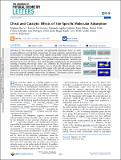Chiral and catalytic effects of site-specific molecular adsorption
Abstract
The changes of properties and preferential interactions based on subtle energetic differences are important characteristics of organic molecules, particularly for their functionalities in biological systems. Only slightly energetically favored interactions are important for the molecular adsorption and bonding to surfaces, which define their properties for further technological applications. Here, prochiral tetracenothiophene molecules are adsorbed on the Cu(111) surface. The chiral adsorption configurations are determined by Scanning Tunneling Microscopy studies and confirmed by first-principles calculations. Remarkably, the selection of the adsorption sites by chemically different moieties of the molecules is dictated by the arrangement of the atoms in the first and second surface layers. Furthermore, we have investigated the thermal effects on the direct desulfurization reaction that occurs under the catalytic activity of the Cu substrate. This reaction leads to a product that is covalently bound to the surface in chiral configurations.
Citation
Borca , B , Michnowicz , T , Aguilar-Galindo , F , Pétuya , R , Pristl , M , Schendel , V , Pentegov , I , Kraft , U , Klauk , H , Wahl , P , Arnau , A & Schlickum , U 2023 , ' Chiral and catalytic effects of site-specific molecular adsorption ' , The Journal of Physical Chemistry Letters , vol. 14 , no. 8 , pp. 2072-2077 . https://doi.org/10.1021/acs.jpclett.2c03575
Publication
The Journal of Physical Chemistry Letters
Status
Peer reviewed
ISSN
1948-7185Type
Journal article
Description
Funding: Open access funded by Max Planck Society. The authors acknowledge the Deutsche Forschungsgemeinschaft (DFG, German Research Foundation) under Germany’s Excellence Strategy-EXC-2123 Quantum Frontiers - 390837967; Core program PC2-PN23080202 and the PN-III-P2-2.1-PED-2021-0378 (contract no. 575PED/2022) granted projects, financed by the Romanian Ministry of Research, Innovation and Digitalization/UEFISCDI; and the generous allocation of computer time at the computing center of Donostia International Physics Center and at the Red Española de Supercomputación (project QHS-2021-2-0019). A.A. acknowledges support from Project No. PID2019-103910GB-I00, funded by MCIN/AEI/10.13039/501100011033/ and FEDER Una manera de hacer Europa, and Project No. IT-1527-22 funded by the Basque Government.Collections
Items in the St Andrews Research Repository are protected by copyright, with all rights reserved, unless otherwise indicated.

